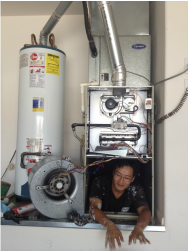Since 2009, I've gone through maybe 40 auditors and crew members... and I'm saying that not to brag, its actually an uncomfortable topic for me. It never feels good to part ways with someone but if my business is hurting because of poor performance the truth is nobody is benefiting. I suspect that finding, training and trusting the people in a home performance crew is not easy for any business owner.
Finding a good fit for staffing your home performance crew can be tough. Guys I've thought would be good assets turned out to be toxic and get me in more trouble than they were worth. I've gone off recommendations of other crew members and been burned. I've had crew members steal from me... and find it a naive mistake, like how a teenage boy tries to impress a girl, how crew members think because I'm the owner I am making a killing and won't really be financially hurt if I take these tools or loose them in an attic. Or how guys will stretch a one day job into a two or even three day job. I've learned to stay away from rosy promises of potential employee (every employee is the best employee until they start working for you), over friendliness, paying out in advance and pity.
Here are some models I've personally used and seen my peers use when paying our crews.
Anyway you go it's best to set expectations up front... These are your responsibilities, pay per job, not by hour and hold people accountable. Those who do not fit will weed themselves out and that is OK! Part of being a business owners is to make tough decisions, suck it up and create new opportunities for the company.
Finding a good fit for staffing your home performance crew can be tough. Guys I've thought would be good assets turned out to be toxic and get me in more trouble than they were worth. I've gone off recommendations of other crew members and been burned. I've had crew members steal from me... and find it a naive mistake, like how a teenage boy tries to impress a girl, how crew members think because I'm the owner I am making a killing and won't really be financially hurt if I take these tools or loose them in an attic. Or how guys will stretch a one day job into a two or even three day job. I've learned to stay away from rosy promises of potential employee (every employee is the best employee until they start working for you), over friendliness, paying out in advance and pity.
Here are some models I've personally used and seen my peers use when paying our crews.
- Hourly. Within hourly I will add there are several different ways to do it. I am currently using a tiered approach at $11 for the first week. If they survive the first week and my crew has good things to say about them I will increase their pay to between $11.50 and $12.50. I was a proponent for higher wages thinking that higher wages would correlate with more honesty, better quality work, better customer service and longer term employees but I have been consistently proved wrong on that theory.
- Hourly or daily plus bonus. I do like this method also and after 1 month of work, an employee will take responsibility for their own work and be rewarded for it. I use a $20 bonus per job per man if QC, customer satisfaction and time metrics are met. It has motivated my guys well and they like having more control over their pay. Financially, it is worth it to me as a business owner to pay the equivalent of $13 - $20 per hr for jobs that are done right the first time, create happy referring customers, and are done on time. We have an agreement with all team members that if something does not pass quality inspections, the responsible parties will go out on their own time to fix the defect. In this industry I am left holding the bag whenever I let an employee or or he quits because of the delayed response between the time of the install and our QC or customer call backs, but it has cut costs down significantly.
- Daily. I know of several companies paying their crews daily between $100 - $175 per day. I used that model at one time and have seen it work for other companies. It is certainly simpler for owners and managers to keep track of pay but it creates unhappy employees if you slow down and start giving guys half days and half days pay or overwork them.
Anyway you go it's best to set expectations up front... These are your responsibilities, pay per job, not by hour and hold people accountable. Those who do not fit will weed themselves out and that is OK! Part of being a business owners is to make tough decisions, suck it up and create new opportunities for the company.

 RSS Feed
RSS Feed